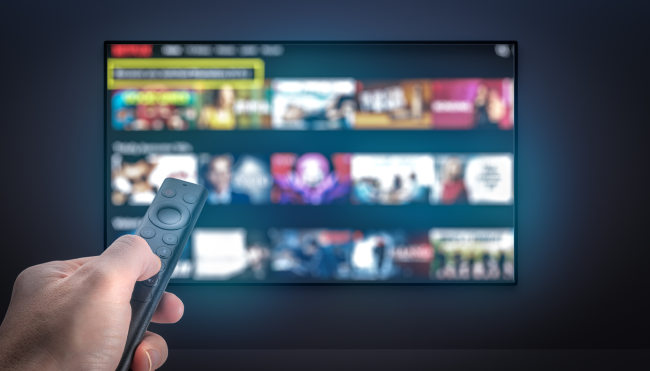- Why Amagi
-
Solutions
Contact UsBusinessWho We Serve
- Offerings
- AI
-
Resources
Contact UsINDUSTRY REPORTSAmagi FAST Report #15: The Power of Live Programming: A Catalyst for Streaming SuccessAugust 21, 2025Read More
-
Company
Contact UsNewsroomAmagi launches AI-powered Smart Scheduler to improve content programmingApril 3, 2025Read More
Blog
FAST 101: A content owner's guide to Free Ad-supported Streaming TV
By Mike Asebrook - September 8, 2023
Over the last two decades, streaming TV has radically changed the way we consume content. Today, viewers have more control over what they watch, how they watch, and how much they want to pay for it. The rising popularity of Connected TV (CTV) indirectly paves the way for the next wave - which is why FAST or Free Ad-supported Streaming TV is rapidly emerging into millions of living rooms across the globe.
For content owners, Free Ad-supported Streaming TV opens the floodgates to a massive new opportunity where they can monetize their expansive content library much easier than ever before. With the worldwide revenue of FAST expected to reach $18 billion by 2028, content owners taking the FAST route are banking on seeing even bigger dollars flow in.
For those who either want a refresher or want to learn what FAST is, this blog is here to help. We’ll cover the fundamentals of FAST, why more and more content owners are switching to the FAST lane, and what the future of FAST looks like.
Let's dive in.
What is Free Ad-supported Streaming TV (FAST)?
FAST, or Free Ad-supported Streaming TV, is the linear distribution model that delivers pre-programmed content to a mass audience via connected devices. As the name suggests, the FAST model offers content for free in exchange for viewers watching a few short advertisements. In terms of usability, FAST is similar to the traditional linear TV viewing experience, but instead of relying on a broadcast or satellite signal, it is streamed over the internet.
For content owners, there are quite a few options as far as streaming models go - including FAST, AVOD (Advertising-supported Video on Demand), and SVOD (Subscription Video on Demand). And while FAST and AVOD appear to be similar, there are some slight nuances between the two. The primary difference is that FAST is linear TV with a blend of fixed programming, schedules, and advertising – offering a lean-back, passive viewing experience. Some popular FAST Services include Tubi, Pluto TV and The Roku Channel. AVOD, though ad-based, is on-demand content distribution that helps viewers actively choose what they want to watch. A few examples of AVOD services are Hulu, Paramount+, Peacock, and Crackle.

With FAST, it’s a much more streamlined experience overall, as all viewers need is a Connected TV (FAST is also available on other connected devices) and an internet connection. This means users aren’t paying monthly streaming subscription fees or monthly cable TV bills – as long as they sit through a few ads.
LEARN MORE: Get in-depth insights on the impressive growth of FAST across the globe in Amagi’s FAST Reports
How does Free Ad-supported Streaming TV work?
FAST channels stream ad-supported content from various content providers and broadcast networks. The system is based on licensing existing movies and TV shows monetized through ads, making them entirely free for the viewer. FAST channels blend the familiarity of traditional broadcasting with the convenience of streaming services. In FAST, the viewer has no control over programming, offering a lean-back viewing experience.
What are the variants of FAST?
FAST channels are broadly classified into three different types based on the platforms or devices they are available on.
- Connected TV-Specific: These channels are only accessible on a few Connected TVs, such as Samsung, LG, and VIDAA.
- Connected device-specific: These channels are available on a limited number of connected devices like Roku, Amazon Fire TV, and Fetch.
- Device agnostic: Device-agnostic channels can be accessed on various connected TVs, smartphones, tablets, and web browsers. For example, Pluto TV can be installed for free on your connected device, allowing you to watch its channel lineup without having to pay.
Why is Free Ad-supported Streaming TV on the rise?
FAST is gaining rapid adoption across the globe. In the US alone, 57% of TV viewers watched content on FAST platforms. Comscore reported a 21% increase in the number of hours streamed by households with CTVs and attributed this increase to the growing use of ad-supported platforms. While the ease of passive watching and free ad-supported service are the primary reasons for viewers switching to FAST, several other reasons fast-forward the shift.
1. Increasing popularity of connected TVs
More and more people are making CTVs a part of their living rooms worldwide. Connected TV Original Equipment Manufacturers (OEMs) like LG and Samsung offer built-in FAST channels, further supporting the growing trend. The CTV adoption rates are a whopping 92% in the US, 41% in Latin America, 87% in India, 82% in New Zealand, 81.2% in Australia, 70% in Western Europe and 50% in Central Europe.
The higher the penetration of CTV, the higher the opportunities for FAST adoption – thereby increasing reach and revenue.
The global connected TV advertising revenue is expected to grow to almost $26 billion in 2023, a 13.2 percent increase from the previous year. In addition, CTV ad spending is projected to exceed $42 billion by 2028. This means more significant milestones are on the horizon for the CTV and FAST business.
2. Increasing number of cost-conscious young viewers
The 2022 Digital Media Trends report from Deloitte exposed an intriguing trend among younger generations. Many of them are canceling their paid video streaming subscriptions (SVOD) only to resubscribe later. This behavior can be attributed to several factors, such as:
- Release of a new season or episode of their favorite TV series
- Availability of a highly discounted subscription deal
- Addition of a movie or series to their 'must-watch' list on a streaming service
Younger audiences are conscious of costs and looking for the most affordable and engaging sources of entertainment.
3. Piling up subscription fatigue
Subscription fatigue refers to viewers being overwhelmed by paying for multiple streaming TV subscriptions. 72% of US consumers say they pay for as many as five subscriptions monthly. Similarly, a typical European pays for three subscription services every month. Given the current economic conditions and people cutting costs, the cost of streaming TV subs is considered a luxury.
This is where FAST comes in as a more attractive alternative – offering premium quality content for free.
4. Difficulty in content discoverability
Ever doze off deciding what to watch and end up watching nothing? With AVOD and SVOD offering so many options, it’s no wonder people can’t figure out what to watch. A recent survey by Accenture and Oxford Economics reports that 72% of streaming consumers become frustrated over finding something to watch, showing that content discoverability is one of the primary challenges for users.
Free Ad-supported Streaming TV, with its linear TV experience, offers seamless viewing. FAST platforms provide content in a predetermined, sequential manner, so viewers only need to tune in and watch. This makes discovering content on FAST platforms easier than competing AVOD and SVOD platforms.
If these are just some of the advantages of FAST for viewers, imagine the lucrative potential for content owners and advertisers alike. Here’s how.
How does FAST level the playing field for content owners and advertisers?
Streaming has opened up new opportunities for content owners and advertisers, and FAST platforms are at the forefront of this revolution. To truly succeed in this market, content owners need to have a broad reach and be able to monetize their content effectively.
FAST platforms offer exactly that - with a phenomenal reach across regions and a growing number of unique users. Unlike traditional broadcasting, these platforms allow content owners to monetize their content innovatively and repurpose their old content in formats that generate more revenue.
CTV advertising is becoming increasingly popular, too. With technologies such as SSAI and innovative and non-intrusive ad formats, advertising is no longer a disruptive experience for viewers. Instead, it enhances their viewing experience, showing ads relevant to their interests and lifestyle.
FAST offers access to a wider audience and provides better chances of monetization, leading to more targeted ads and better engagement.
What is the future of Free Ad-supported Streaming TV (FAST)?
TVREV's 'FASTs Are The New Cable' report states that, currently, cable and broadcasters contribute to $62 billion of the $89 billion total TV ad spends, the rest being SVOD and FAST. With FAST becoming commonplace, the report predicts that by 2027, FAST will be the primary contributor with $42 billion of $100 billion total TV ad spend.
The emergence of FAST has enabled consumers to access free content through ad exposure while offering content owners new revenue streams and platforms more content to engage users. Big players like Samsung TV Plus, The Roku Channel, Xumo, VIZIO, Plex, Redbox, Pluto, Sling, fuboTV, and others are revolutionizing the FAST landscape. In the US alone, there are more than 1,400 FAST channels. With so many options and content available in the streaming world, FAST will continue to cater to consumers' preferences.
Making Free Ad-supported Streaming TV an extremely personalized experience by offering a device-level personalized Electronic Program Guide (EPG) will also revolutionize FAST. You can read more about personalized EPG in Amagi's exclusive insights.
Get all the details on FAST and the prerequisites to getting on the FAST bandwagon in our whitepaper. You can also learn more with Amagi Consulting Services.
For more on how Amagi can help you get in the FAST lane or transform your existing FAST strategy, get in touch with us.
Related Blogs
Get started
Increase revenue and reach with our Broadcast & Streaming solutions.
Cloud modernization. Streaming unification. Monetization. Marketplace.
 German
German French
French Spanish
Spanish Korean
Korean Japanese
Japanese Portuguese
Portuguese


